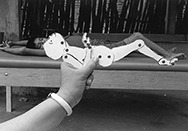Hesperian Health Guides
Measuring Joint Positions and Contractures
HealthWiki > Disabled Village Children > Chapter 5: Simple Ways to Measure and Record a Child’s Progress > Measuring Joint Positions and Contractures
Contents
MEASURING JOINT POSITIONS AND CONTRACTURES
You can make a simple measuring tool using 2 flat pieces of wood, plastic, or cardboard. (Tongue depressors work well.) See other simple methods for recording joint positions.
| 1. Rivet the pieces together on one end. | 2. Line them up exactly with the joint. |
 |
 |
| 3. Trace the angle on paper. | 4. Do this again every 1 or 2 weeks to see if the joint is straightening with exercise. |
 |
 |
The flexikin — an aid to measure and encourage progress
 |
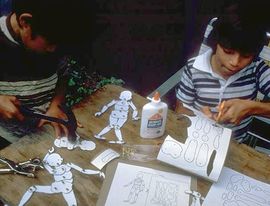 |
| Flexikins—front and side view models | Children making and playing with flexikins. In the PROJIMO village rehabilitation center, all the flexikins used are made by children with disabilities and the local school children. |
Flexikins are cardboard dolls with joints. Children with and without disabilities can make and play with them. They are so easy to use that even parents who cannot read can measure and record their children’s contractures. Because the periodic measurements are recorded as a line of pictures, anyone can see the child’s progress at a glance.
We have found that when families follow their child’s progress using flexikins, both the child and parents are more likely to keep doing stretching exercises. As a result, many contractures can be partly or completely straightened in the home, and there is less need for casting and surgery.
Examples of how flexikins are used
 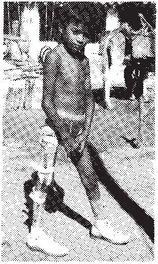 |
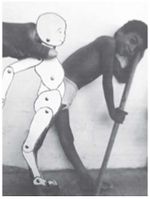 The mother places the flexikin’s leg in the same position as her son’s leg, bent back as far as it goes. She then traces it onto a large sheet of paper. 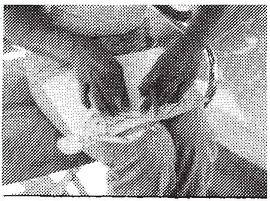 |
 FEB 2
MAR 6
APR 10
MAY 10
JUNE 8
JULY 4
AUG 7
SEPT 1
|
Each month she does the same and records the date. (In April her son did not use the brace for 2 weeks and she saw the knee was getting worse. This convinced both mother and boy of the importance of using the brace.) |
The flexikins can be used to record a wide variety of positions, deformities, contractures, and limitations in range of motion, mainly of the arms and legs but also of the neck, back, hips, and body:
 swayback
hand very bent
head leans backward
neck forward
hand bent up
knees bent backward
|
 hunch-backed
fallen hand
knees bent forward
|
 You can draw both arms and legs. First one and then the other, like this:
feet contracted (twisted) downward
knee contracted
elbow and hand contracted
|
 head to one side
knees together and feet separated
feet turned inward
|
 trunk twisted
hip tilts to one side
“tiptoe” contracture
this shoulder higher than the other
spine curved
|
 (Draw the spine by looking at the child after you have marked each vertebra with a marker.)
|
In addition to using the small flexikins for record keeping, you can make large flexikins for group teaching. Or use them to keep body proportions correct when making drawings for instruction sheets.
Note: For recording contractures, we have found the side-view flexikin more useful than the front-view one. The side-view flexikin is also easier to make. It is probably the only one you will need for evaluating a child’s progress.
How to make the flexikins
| 1.Trace the patterns of different pieces (side-view or front-view) onto very thick paper or thin, firm cardboard. Or use old X-ray film. You can do this using carbon paper. (Make your own carbon paper by completely blackening a sheet of paper with a soft-leaded pencil.) Or you can glue a copy of the pattern sheet directly to the cardboard. (If your program plans to make many flexikins, or have children make them, we suggest you have the patterns printed or photocopied directly on sheets of thin, firm cardboard.) |  cardboard
carbon paper
pattern sheet | |
| 2. Cut out the pieces with strong scissors, shears, or a piece of razor blade. | 
piece of razor blade in the split end of a stick |
| 3. Place the pieces together as shown in the drawings. Make sure the pieces that overlap with dotted lines go behind those with complete lines. |  |
 Put this piece
behind this piece, and put this piece
behind this. |
| Or use sewing pins |
 |
| Cut here and put a drop of very strong glue (like epoxy) here. |
| Or use thin wire or string and tie knots. |
| Or string the joints together with thread or yarn (this does not work as well). |
 |
Metal or plastic rivets usually work best

For metal rivets: Use the smallest metal rivets you can find. First punch a hole through each black dot. Put the rivets through and hammer them just enough so that the cardboard joints are tight enough to hold their position but can be moved without tearing.

For plastic rivets: Use small pieces of plastic cut from a plastic drinking straw, or a plastic knitting needle or crochet hook. A drinking straw will be easier to use, but make sure it is made from plastic and not paper. Put small pieces of the plastic into each hole you have punched. Then use a lighted candle to heat a knife or metal blade to press and melt the plastic so it will get soft, spread, and hold the cardboard pieces together. Do not melt it too much or the 2 pieces of cardboard will stick together and you will not be able to move the flexikin ‘joint’.
You can copy this sheet, or one like it, and give it to parents together with a flexikin. Be sure that you also show them how to use it and then watch them use it.
| INSTRUCTIONS FOR USING THE FLEXIKIN | |||||
| We have given you a ‘flexikin’ so that you can measure and see the progress that your child is making with his exercises or aids. We suggest you take a new measurement every_____________________________ . Do it like this:
| |||||
 |
This example shows how exercises have helped straighten a contracted knee. | ||||
| For later recordings, you only need to trace the part or parts you are measuring. Each time you record a measurement, write the date. | |||||
| In certain cases you may want to measure how far the child can straighten an arm or leg by herself, and how far you are able to straighten it for her (little by little without forcing). | |||||

CAUTION! When you straighten the limb, support it close to the joint. This prevents injury. | |||||
| Make 2 columns. In one, record how far the child can move it by herself. In the other column record how far she can move it with help. | |||||
| Here you see the progress of a leg until it became straight and a brace could be made for it. |  Problem: Right Knee Contracture
Name: Maria Lopez
Date (1983)
Range-of-Motion:
Child alone
With help
March 1
April 1
May 1
June 10
July 5
August 8
(she got a leg brace)
with the brace
September 15
with the brace
|
||||
SIDE-VIEW FLEXIKIN
Patterns of pieces for making it


FRONT-VIEW FLEXIKIN
Patterns of pieces for making it






